Regeneration of Post-Agricultural Brownfield for Social Care Needs in Rural Community: Is There Any Transferable Experience?
Abstract
:1. Introduction
1.1. Post-Agricultural Brownfields in Rural Space
1.2. Local Actors, Local Activity, and the Public–Private Partnership Principle
2. Case Study, Materials, and Methods
2.1. Case Study Description
2.2. Methods and Data
3. Results. Regeneration Journey: How a Small Community Can Achieve Big Things
3.1. Vision of the Project and the Search for Funding
3.2. Architectural, Technical, and Social Challenges Related to the Regeneration Process
3.3. Regeneration Result and Ex-Post Evaluation of the Project
4. Discussion
5. Conclusions
Author Contributions
Funding
Institutional Review Board Statement
Informed Consent Statement
Data Availability Statement
Conflicts of Interest
References
- Naumann, M.; Rudolph, D. Conceptualizing rural energy transitions: Energizing rural studies, ruralizing energy research. J. Rural Stud. 2020, 73, 97–104. [Google Scholar] [CrossRef]
- Hewitt, R.J.; De Boer, C.; Flacke, J. Participatory development of digital support tools for local-scale energy transitions: Lessons from two European case studies. Glob. Transit. 2020, 2, 138–149. [Google Scholar] [CrossRef]
- Johnson, K.M.; Lichter, D.T. Rural depopulation: Growth and decline processes over the past century. Rural Sociol. 2019, 84, 3–27. [Google Scholar] [CrossRef] [Green Version]
- Sikorski, D.; Latocha, A.; Szmytkie, R.; Kajdanek, K.; Miodońska, P.; Tomczak, P. Functional changes in peripheral mountainous areas in east central Europe between 2004 and 2016 as an aspect of rural revival? Kłodzko County case study. Appl. Geogr. 2020, 122, 102223. [Google Scholar] [CrossRef]
- Bresnihan, P.; Hesse, A. Political ecologies of infrastructural and intestinal decay. Environ. Plan. E Nat. Space 2021, 4, 778–798. [Google Scholar] [CrossRef]
- Scoones, I.; Edelman, M.; Borras, S.M., Jr.; Hall, R.; Wolford, W.; White, B. Emancipatory rural politics: Confronting authoritarian populism. J. Peasant Stud. 2018, 45, 1–20. [Google Scholar] [CrossRef] [Green Version]
- Navrátil, J.; Krejčí, T.; Martinát, S.; Frazier, R.J.; Klusáček, P.; Pícha, K.; Škrabal, J.; Osman, R. Variation in brownfield reuse of derelict agricultural premises in diverse rural spaces. J. Rural Stud. 2021, 87, 124–136. [Google Scholar] [CrossRef]
- Lowe, P.; Phillipson, J.; Proctor, A.; Gkartzios, M. Expertise in rural development: A conceptual and empirical analysis. World Dev. 2019, 116, 28–37. [Google Scholar] [CrossRef]
- Hadžić, A.P. Institutional cooperation in the brownfield regeneration process: Experiences from Central and Eastern European countries. Eur. Spat. Res. Policy 2016, 23, 21–46. [Google Scholar]
- Klusáček, P.; Alexandrescu, F.; Osman, R.; Malý, J.; Kunc, J.; Dvořák, P.; Frantál, B.; Havlíček, M.; Krejčí, T.; Martinát, S.; et al. Good governance as a strategic choice in brownfield regeneration: Regional dynamics from the Czech Republic. Land Use Policy 2018, 73, 29–39. [Google Scholar] [CrossRef]
- Bianchi, C.; Bereciartua, P.; Vignieri, V.; Cohen, A. Enhancing urban brownfield regeneration to pursue sustainable community outcomes through dynamic performance governance. Int. J. Public Adm. 2021, 44, 100–114. [Google Scholar] [CrossRef]
- Bartke, S.; Martinát, S.; Klusáček, P.; Pizzol, L.; Alexandrescu, F.; Frantál, B.; Critto, A.; Zabeo, A. Targeted selection of brownfields from portfolios for sustainable regeneration: User experiences from five cases testing the Timbre Brownfield Prioritization Tool. J. Environ. Manag. 2016, 184, 94–107. [Google Scholar] [CrossRef] [Green Version]
- Limasset, E.; Pizzol, L.; Merly, C.; Gatchett, A.M.; Le Guern, C.; Martinát, S.; Klusáček, P.; Bartke, S. Points of attention in designing tools for regional brownfield prioritization. Sci. Total Environ. 2018, 622, 997–1008. [Google Scholar] [CrossRef] [PubMed] [Green Version]
- Pizzol, L.; Zabeo, A.; Klusáček, P.; Giubilato, E.; Critto, A.; Frantál, B.; Martinát, S.; Kunc, J.; Osman, R.; Bartke, S. Timbre Brownfield Prioritization Tool to support effective brownfield regeneration. J. Environ. Manag. 2016, 116, 178–192. [Google Scholar] [CrossRef] [PubMed]
- Kernecker, M.; Knierim, A.; Wurbs, A.; Kraus, T.; Borges, F. Experience versus expectation: Farmers’ perceptions of smart farming technologies for cropping systems across Europe. Precis. Agric. 2020, 21, 34–50. [Google Scholar] [CrossRef]
- Frantál, B.; Kunc, J.; Nováková, E.; Klusáček, P.; Martinát, S.; Osman, R. Location Matters! Expploring Brownfields regeneration in a Spatial Context (Case Study of the South Moravian Region, Czech Republic). Morav. Geogr. Rep. 2013, 21, 5–19. [Google Scholar]
- Netrdová, P.; Nosek, V. Spatial patterns of unemployment in Central Europe: Emerging development axes beyond the Blue Banana. J. Maps 2016, 12, 701–706. [Google Scholar] [CrossRef]
- Squires, G.; Hutchison, N. Barriers to affordable housing on brownfield sites. Land Use Policy 2021, 102, 105276. [Google Scholar] [CrossRef]
- Lange, D.; McNeil, S. Clean it and they will come? Defining successful brownfield development. J. Urban Plan. Dev. 2004, 130, 101–108. [Google Scholar] [CrossRef]
- Skála, J.; Vácha, R.; Čechmánková, J.; Horváthová, V. Various Aspects of the Genesis and Perspectives on Agricultural Brownfields in the Czech Republic. Morav. Geogr. Rep. 2013, 21, 46–55. [Google Scholar] [CrossRef] [Green Version]
- Osman, R.; Frantál, B.; Klusáček, P.; Kunc, J.; Martinát, S. Factors affecting brownfield regeneration in post-socialist space: The case of the Czech Republic. Land Use Policy 2015, 48, 309–316. [Google Scholar] [CrossRef]
- Frantál, B.; Kunc, J.; Klusáček, P.; Martinát, S. Assessing Success Factors of Brownfields Regeneration: Inter-national and Inter-stakeholder Perspective. Transylv. Rev. Adm. Sci. 2015, 44E, 91–107. [Google Scholar]
- Thornton, G.; Franz, M.; Edwards, D.; Pahlen, G.; Nathanail, P. The challenge of sustainability: Incentives for brownfield regeneration in Europe. Environ. Sci. Policy 2007, 10, 116–134. [Google Scholar] [CrossRef]
- Alexandrescu, F.; Osman, R.; Klusáček, P.; Malý, J. Taming the genius loci? Contesting post-socialist creative industries in the case of Brno’s former prison. Cities 2020, 98, 102578. [Google Scholar] [CrossRef]
- Malý, J.; Alexandrescu, F.; Osman, R.; Klusáček, P. Rebuilding a community ‘centre’ under free-market pressure: The post-socialist experience with local brownfield management. Territ. Politics Gov. 2021, 1–21. [Google Scholar] [CrossRef]
- Klusáček, P.; Krejčí, T.; Martinát, S.; Kunc, J.; Osman, R.; Frantál, B. Regeneration of agricultural brownfields in the Czech Republic: Case study of the South Moravian Region. Acta Univ. Agric. Silvic. Mendel. Brun. 2013, 61, 547–561. [Google Scholar] [CrossRef] [Green Version]
- Bostenaru Dan, M.; Bostenaru-Dan, M.M. Greening the Brownfields of Thermal Power Plants in Rural Areas, an Example from Romania, Set in the Context of Developments in the Industrialized Country of Germany. Sustainability 2021, 13, 3800. [Google Scholar] [CrossRef]
- Gregorová, B.; Hronček, P.; Tometzová, D.; Molokáč, M.; Čech, V. Transforming Brownfields as Tourism Destinations and Their Sustainability on the Example of Slovakia. Sustainability 2020, 12, 10569. [Google Scholar] [CrossRef]
- Kantor-Pietraga, I.; Zdyrko, A.; Bednarczyk, J. Semi-Natural Areas on Post-Mining Brownfields as an Opportunity to Strengthen the Attractiveness of a Small Town. An Example of Radzionków in Southern Poland. Land 2021, 10, 761. [Google Scholar] [CrossRef]
- Lai, Y.; Jiang, L.; Xu, X. Exploring Spatio-Temporal Patterns of Urban Village Redevelopment: The Case of Shenzhen, China. Land 2021, 10, 976. [Google Scholar] [CrossRef]
- Sardinha, I.D.; Craveiro, D.; Milheiras, S. A sustainability framework for redevelopment of rural brownfields: Stakeholder participation at SÃO DOMINGOS mine, Portugal. J. Clean. Prod. 2013, 57, 200–208. [Google Scholar] [CrossRef]
- Klusáček, P.; Martinát, S.; Krejčí, T.; Bartke, S. Re-development of a former military training area—The case of Brdy told from a local actors’ perspective. Land Use Policy 2019, 82, 147–157. [Google Scholar] [CrossRef]
- Klusáček, P.; Martinát, S.; Krejčí, T.; Kunc, J.; Hercik, J.; Havlíček, M.; Skokanová, H. Return of the Local Democracy to the Territory of the Military Training Areas (Case Study the Czech Republic). Communist Post-Communist Stud. 2020, 53, 191–213. [Google Scholar] [CrossRef]
- Navrátil, J.; Martinát, S.; Krejčí, T.; Pícha, K.; Klusáček, P.; Škrabal, J.; Osman, R. The fate of socialist agricultural premises: To agricultural ‘brownfields’ and back again? Morav. Geogr. Rep. 2019, 27, 207–216. [Google Scholar] [CrossRef] [Green Version]
- Szmytkie, R. Suburbanisation processes within and outside the city: The development of intra-urban suburbs in Wrocław, Poland. Morav. Geogr. Rep. 2021, 29, 149–165. [Google Scholar] [CrossRef]
- Pénzes, J.; Demeter, G. Peripheral areas and their distinctive characteristics: The case of Hungary. Morav. Geogr. Rep. 2021, 29, 217–230. [Google Scholar] [CrossRef]
- Alexandrescu, F.; Martinát, S.; Klusáček, P.; Bartke, S. The Path from Passivity Toward Entrepreneurship: Public Sector Actors in Brownfield Regeneration Processes in Central and Eastern Europe. Organ. Environ. 2014, 27, 181–201. [Google Scholar] [CrossRef] [Green Version]
- Fernandes, A.; Figueira de Sousa, J.; Costa, J.P.; Neves, B. Mapping stakeholder perception on the challenges of brownfield sites’ redevelopment in waterfronts: The Tagus Estuary. Eur. Plan. Stud. 2020, 28, 2447–2464. [Google Scholar] [CrossRef]
- Navrátil, J.; Krejčí, T.; Martinát, S.; Pasqualetti, M.J.; Klusáček, P.; Frantál, B.; Tocháčkova, K. Brownfields do not “only live twice”: The possibilities for heritage preservation and the enlargement of leisure time activities in Brno, the Czech Republic. Cities 2018, 74, 52–63. [Google Scholar] [CrossRef] [Green Version]
- Galčanová, L.; Staveník, A. Ageing in the changing countryside: The experience of rural Czechs. Sociol. Rural. 2020, 60, 329–356. [Google Scholar] [CrossRef]
- Glumac, B.; Han, Q.; Schaefer, W.; Krabben, E. Negotiation issues in forming public–private partnerships for brownfield redevelopment: Applying a game theoretical experiment. Land Use Policy 2015, 47, 66–77. [Google Scholar] [CrossRef]
- Adams, D.; Disberry, A.; Hutchison, N.; Munjoma, T. Taxes, Subsidies and the behaviour of brownfield owners. Land Use Policy 2020, 17, 135–145. [Google Scholar] [CrossRef]
- Ženka, J.; Šťastná, S.; Pavlik, A. The role of manufacturing in the development of rural regions: Evidence from a highly industrialised Moravian region. Morav. Geogr. Rep. 2021, 29, 39–52. [Google Scholar] [CrossRef]
- Turečková, K.; Nevima, J.; Duda, D.; Tuleja, P. Latent structures of brownfield regeneration: A case study of regions of the Czech Republic. J. Clean. Prod. 2021, 311, 127478. [Google Scholar] [CrossRef]
- Vojvodíková, B.; Fojtík, R.; Tichá, I. Design and Verification of a Simple Approach to Brownfields Categorization. Sustainability 2021, 13, 11206. [Google Scholar] [CrossRef]
- Kubeš, J.; Chvojková, A. Back to peripheries based on remoteness. Human capital in the peripheral municipalities of South Bohemia. J. Rural Stud. 2020, 79, 116–124. [Google Scholar] [CrossRef]
- Konečný, O.; Šilhan, Z.; Chaloupková, M.; Svobodová, H. Area-based approaches are losing the essence of local targeting: LEADER/CLLD in the Czech Republic. Eur. Plan. Stud. 2021, 29, 619–636. [Google Scholar] [CrossRef]
- Siemiatycki, M. Public-private partnership networks: Exploring business-government relationships in United Kingdom transportation projects. Econ. Geogr. 2011, 87, 309–334. [Google Scholar] [CrossRef]
- Klijn, E.H.; Teisman, G.R. Institutional and strategic barriers to public—private partnership: An analysis of Dutch cases. Public Money Manag. 2003, 23, 137–146. [Google Scholar] [CrossRef] [Green Version]
- Hodge, G.; Greve, C. Public-private partnerships: Governance scheme or language game? Aust. J. Public Adm. 2010, 69, S8–S22. [Google Scholar] [CrossRef]
- Linder, S.H. Coming to terms with the public-private partnership: A grammar of multiple meanings. Am. Behav. Sci. 1999, 43, 35–51. [Google Scholar] [CrossRef]
- Chin, J.T. The shifting role of public–private partnerships in vacant property redevelopment. Land Use Policy 2021, 105, 105430. [Google Scholar] [CrossRef]
- Population of Municipalities (2021): Czech Statistical office. Available online: https://www.czso.cz/csu/czso/population-of-municipalities-1-january-2021 (accessed on 17 November 2021).
- Helikar, J. Revitalizace Bývalého Zemědělského Družstva ve Vranovicích. 2019. Available online: https://www.rrajm.cz/projekty-rrajm/brownfieldy/seminare/regenerace-brownfieldu-v-jihomoravskem-kraji-2019/ (accessed on 17 November 2021).
- Regenerace Brownfieldů. RRAJM. 2016. Available online: https://www.rrajm.cz/projekty-rrajm/brownfieldy/publikace/ (accessed on 1 July 2021).
- Brownfieldy Jihomoravského Kraje. RRAJM. 2018. Available online: https://www.rrajm.cz/projekty-rrajm/brownfieldy/publikace/ (accessed on 29 November 2021).
- Public Database. Czech Statistical Office. 2021. Available online: https://vdb.czso.cz/vdbvo2/faces/en/index.jsf?page=vystup-objekt-vyhledavani&pvo=RSO36&vyhltext=Vranovice&bkvt=VnJhbm92aWNl&z=T&f=TABULKA&katalog=all&pvokc=65&pvoch=6213&c=v371~2__RP2020MP12DP31 (accessed on 17 April 2021).
- Dům Pro Seniory Vranovice. Jak se Stavěl Dům. DPS Vranovice. 2021. Available online: https://dpsvranovice.cz/fotogalerie/jak-se-stavel-dum-4/ (accessed on 16 April 2021).
- Obec Vranovice. Dům pro Seniory–Nejlepší Stavba Roku 2014 pro Sociální Bydlení. Vranovice. 2014. Available online: https://vranovice.eu/dum-pro-seniory-nejlepsi-stavba-roku-2014-pro-socialni-bydleni/ (accessed on 16 April 2021).
- Historical Orthophotomaps 2003. Mapy.cz. 2021. Available online: https://mapy.cz/letecka-2003?x=16.6099080&y=48.9639462&z=18 (accessed on 4 April 2021).
- Historical Orthophotomaps 2015. Mapy.cz. 2021. Available online: https://mapy.cz/letecka-2015?x=16.6099080&y=48.9639462&z=18 (accessed on 4 April 2021).
- Stavba Roku 2014. 2015. Available online: https://www.youtube.com/watch?v=BkHtpP1hAgo (accessed on 25 September 2021).
- McCarthy, L. The brownfield dual land-use policy challenge: Reducing barriers to private redevelopment while connecting reuse to broader community goals. Land Use Policy 2002, 19, 287–296. [Google Scholar] [CrossRef]
- Cuthill, M.; Fien, J. Capacity building: Facilitating citizen participation in local governance. Aust. J. Public Adm. 2005, 64, 63–80. [Google Scholar] [CrossRef]
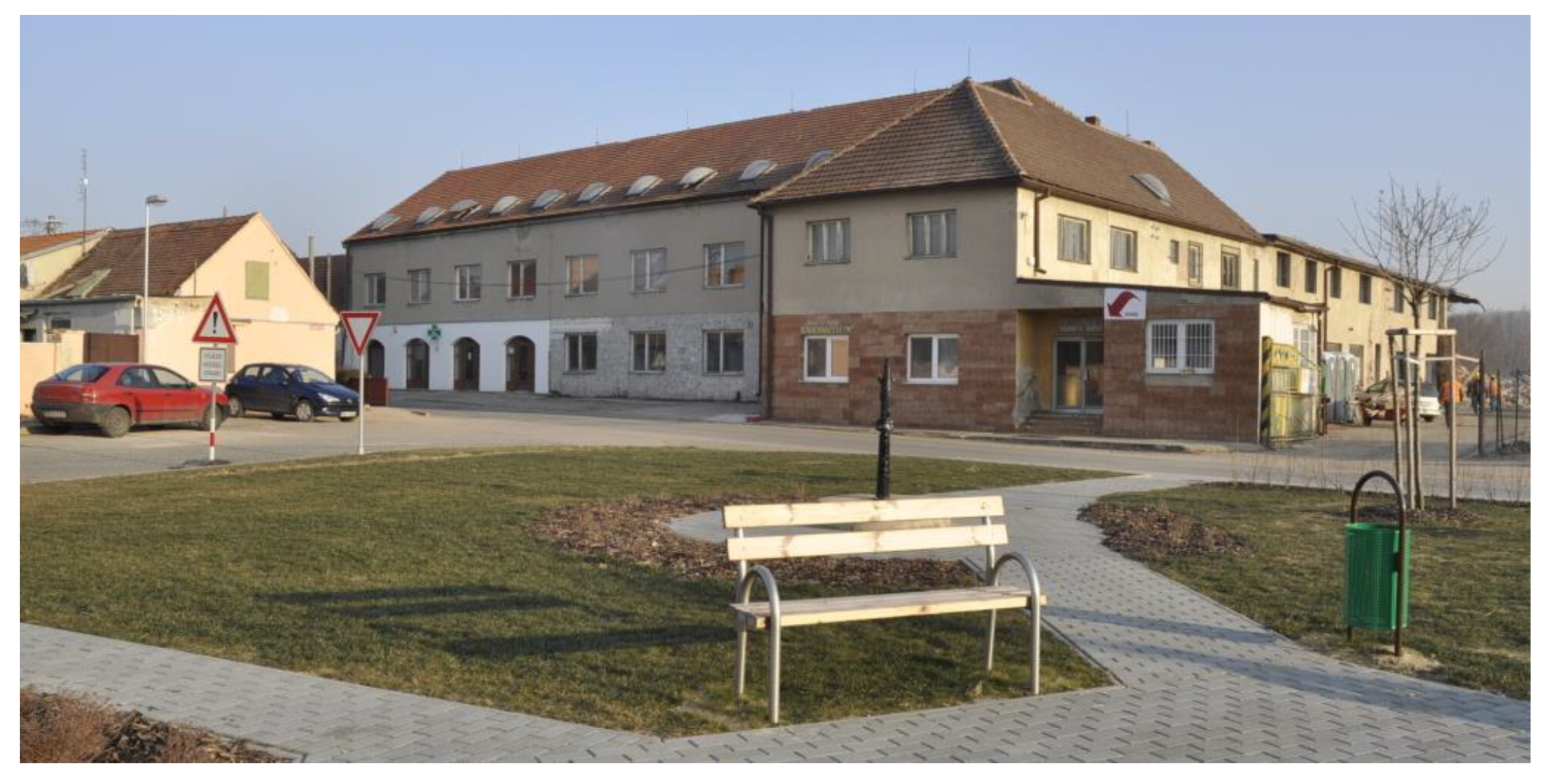
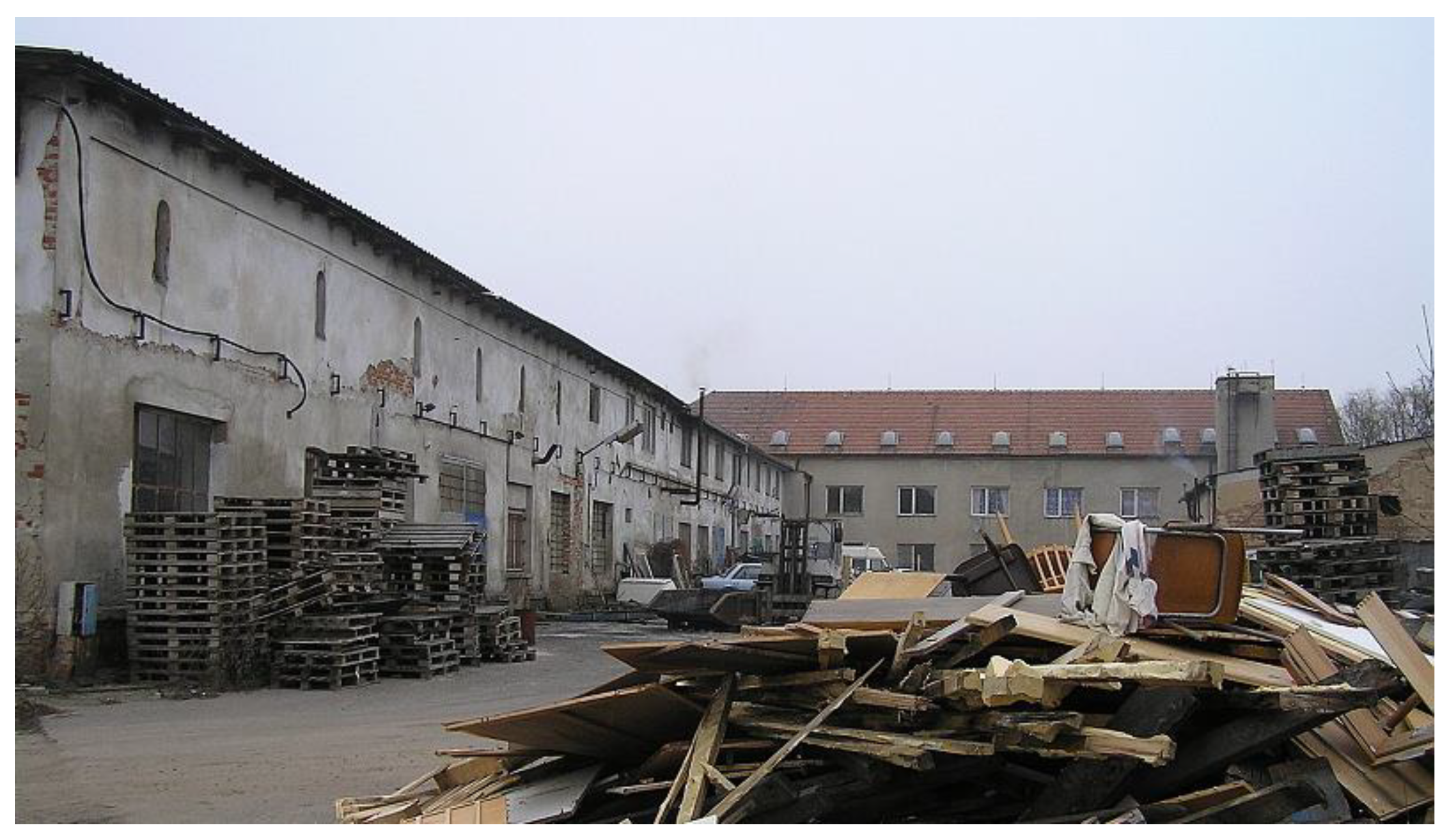
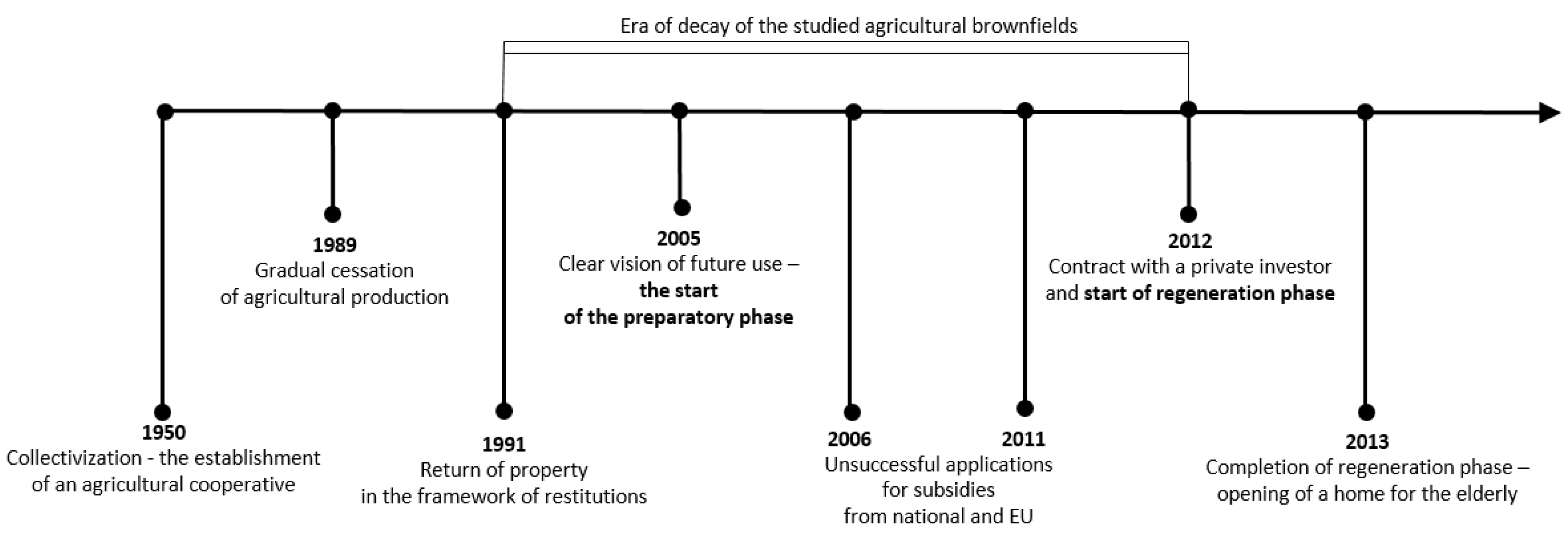
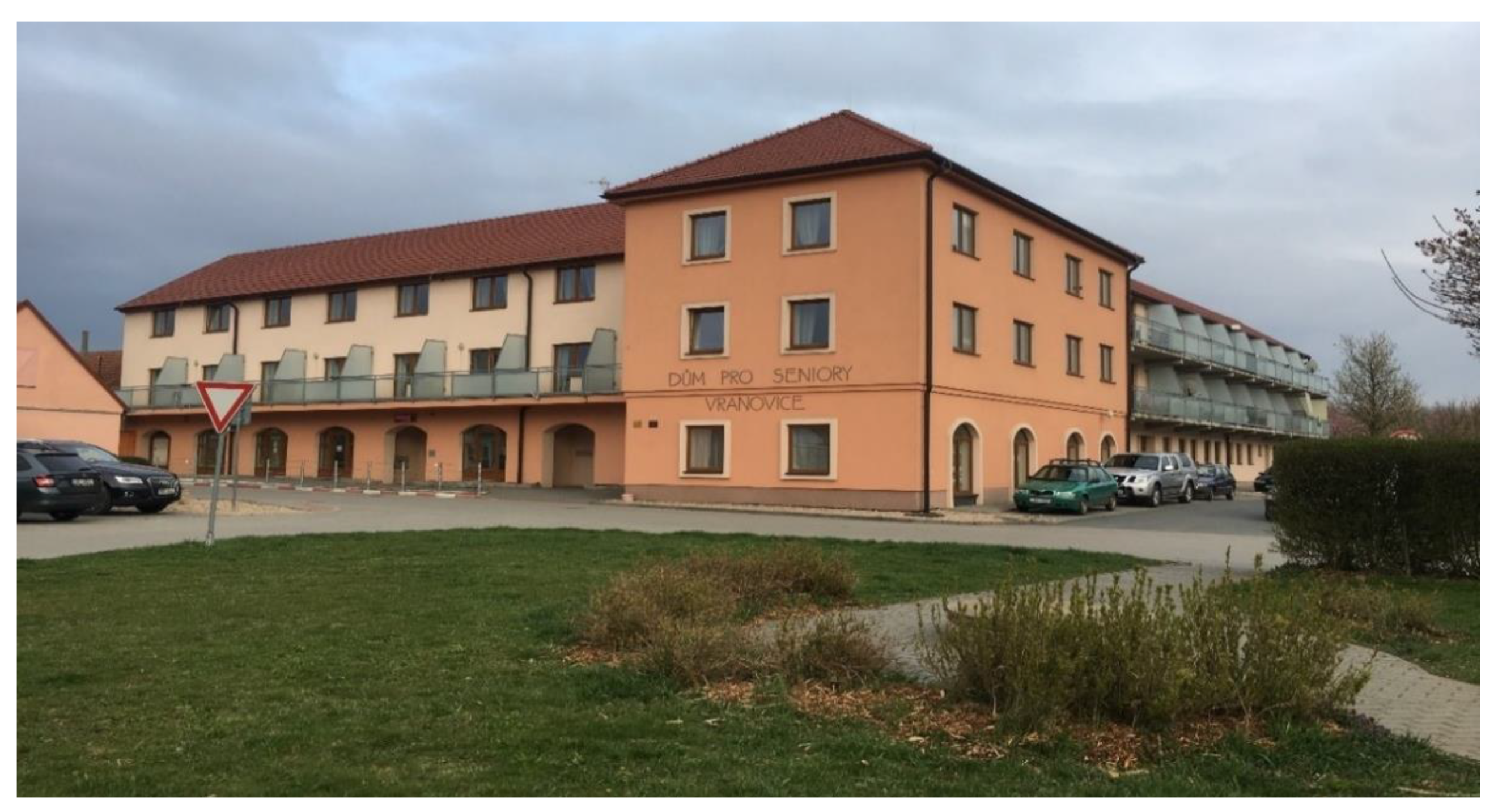
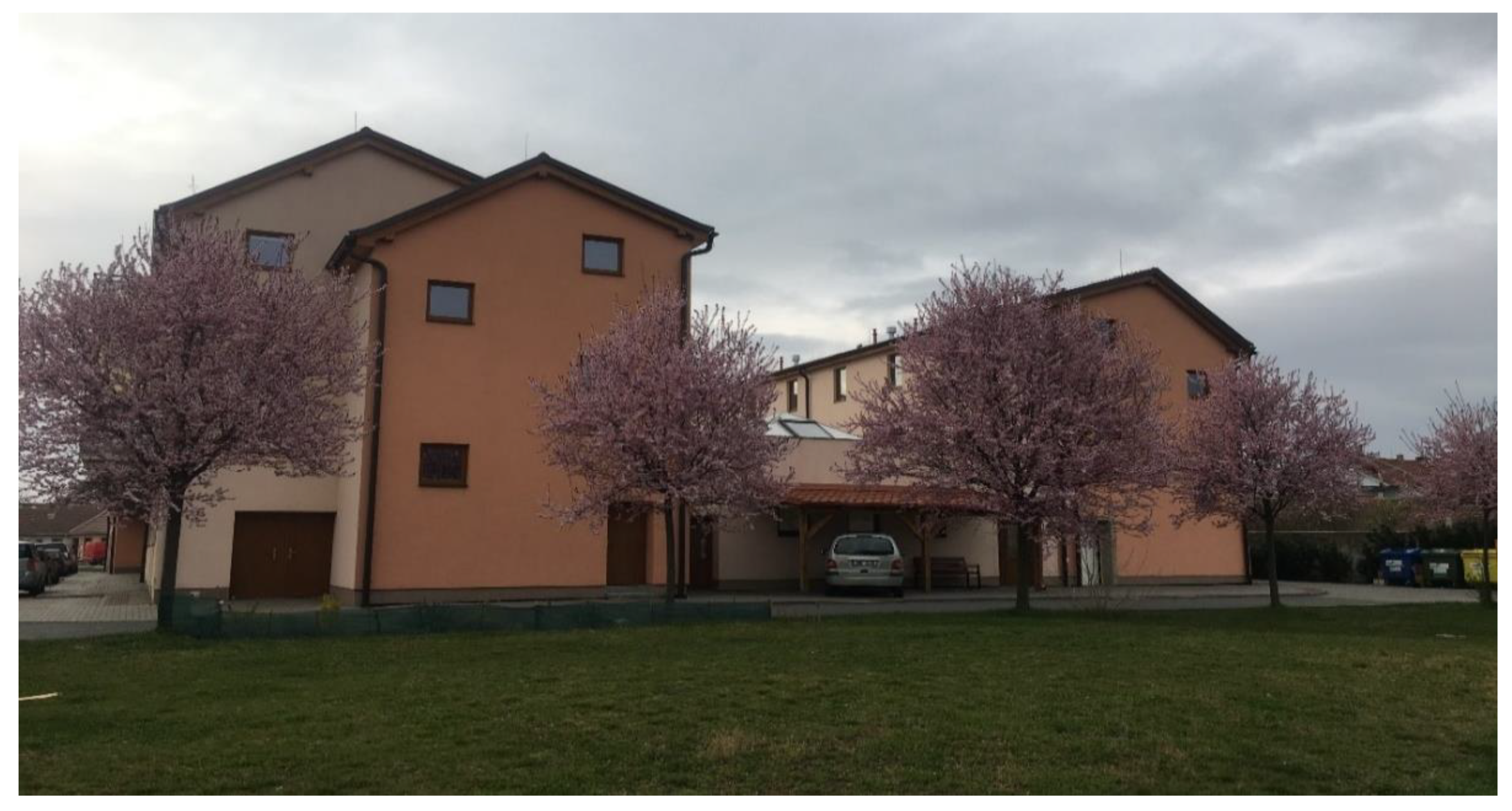
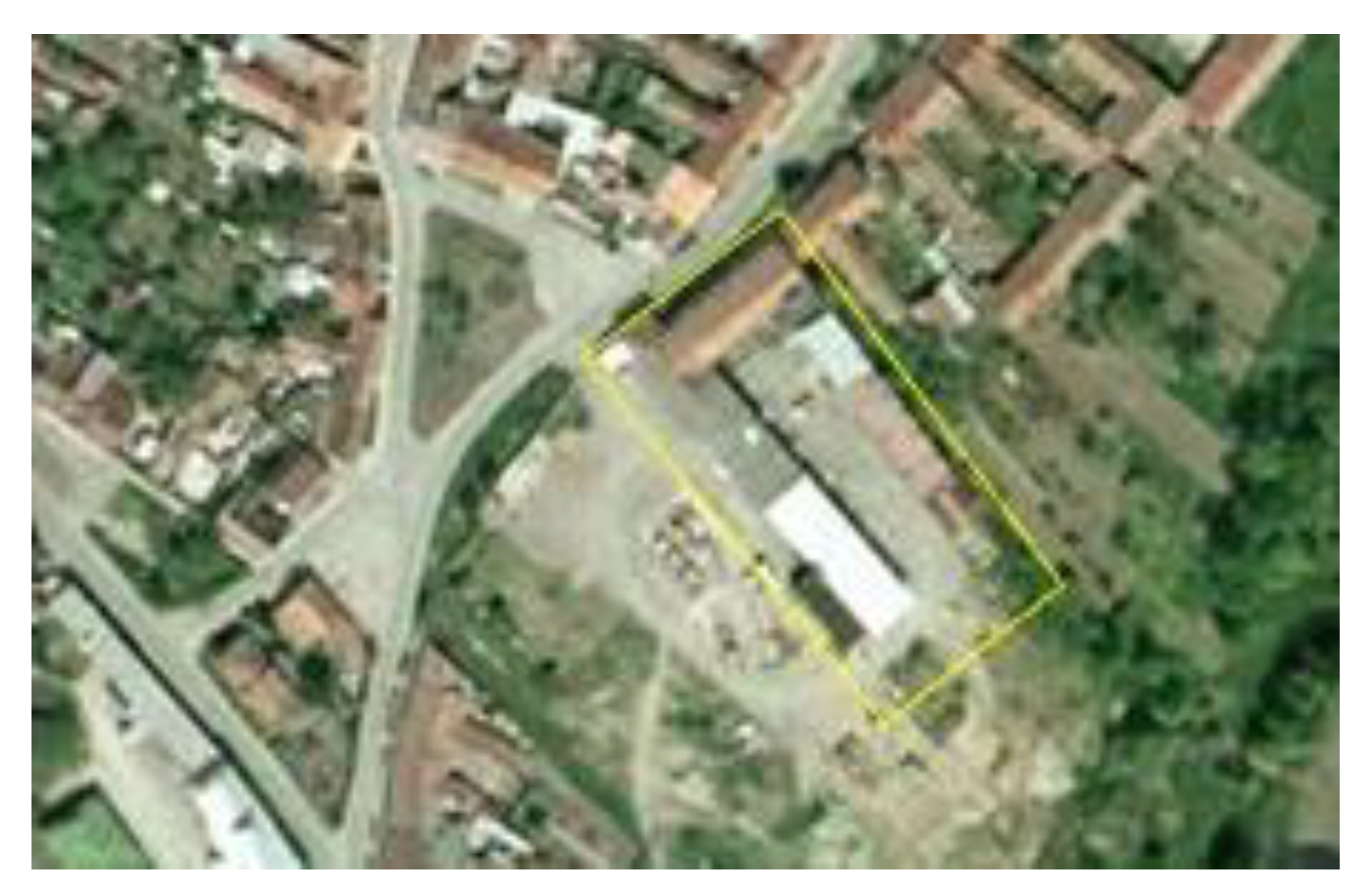
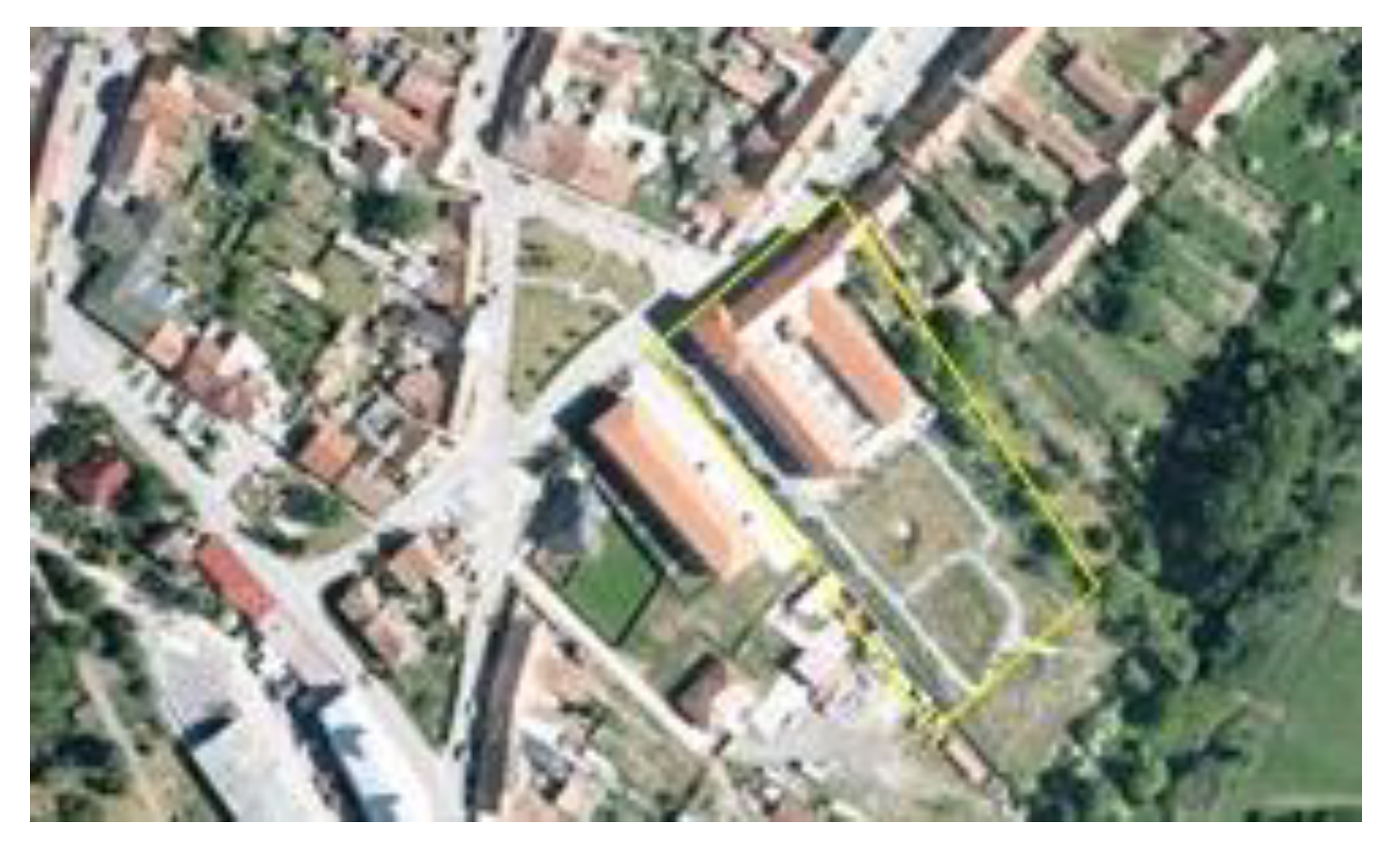
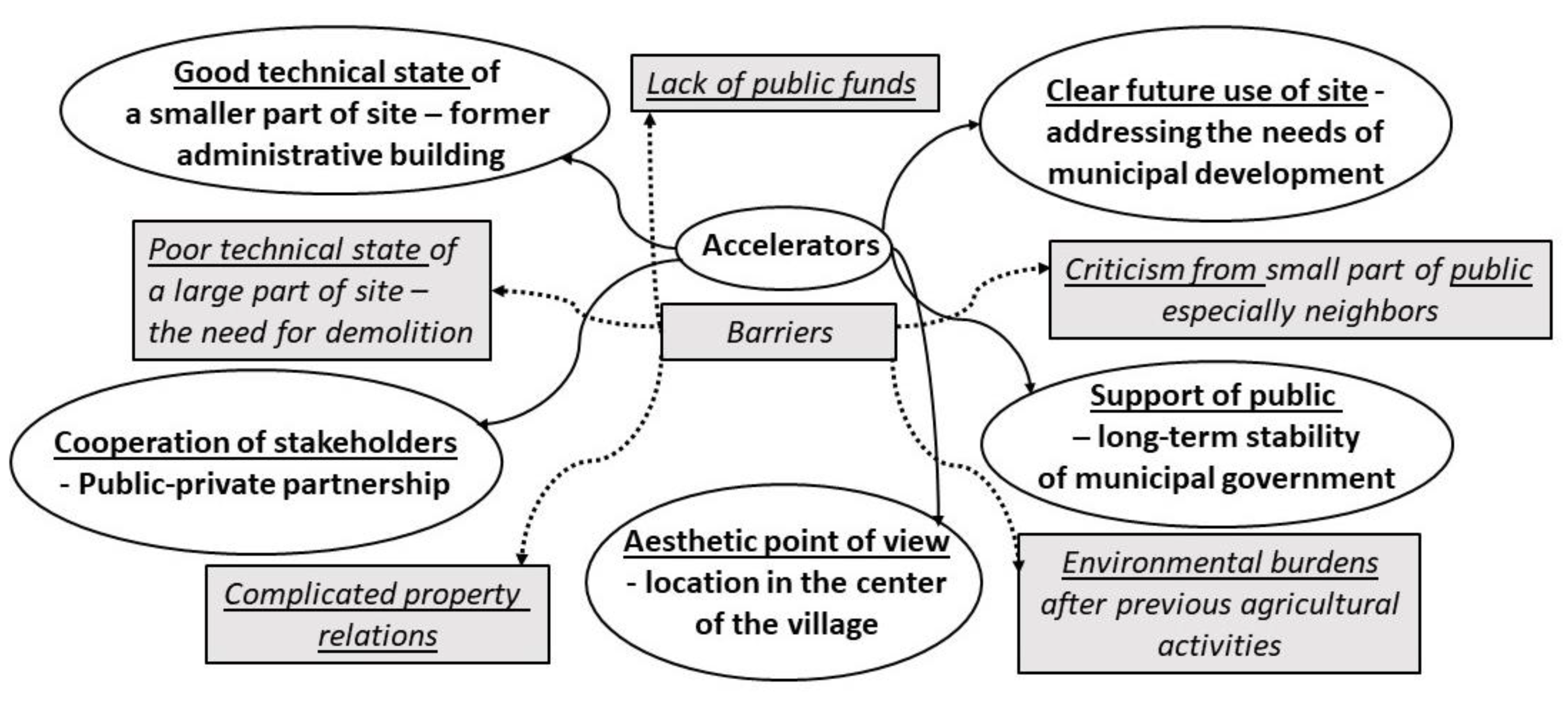
| Characteristic | Description |
|---|---|
| Investments in the construction of the social care home for elderly people | EUR 1920 million |
| Investments in the park and public greenery around a new home | EUR 77 thousand |
| Total capacity of elderly people | 80 elderly persons |
| Kitchen capacity—catering services for elderly people, students of local elementary schools, and other public | 350 meals a day |
| Start and completion of the regeneration project | March 2012–May 2013 |
| Communication Partner | Sex (F/M) | Education | Age Category (Years) | Position |
|---|---|---|---|---|
| No. 1 | M | University | 50–60 | Mayor—Internal actor |
| No. 2 | M | High school | 40–50 | Deputy Mayor—Internal actor |
| No. 3 | F | University | 30–40 | Member of municipal council—Internal actor |
| No. 4 | F | University | 40–50 | Architect—Internal actor |
| No. 5 | M | University | 60–70 | Representative of a private company operating the home—Internal actor |
| No. 6 | F | University | 30–40 | External actor—Project evaluator No. 1—Representative of the State Housing Development Fund |
| No. 7 | M | University | 60–70 | External actor—Project evaluator No. 2—Representative of Foundation for the Development of Building and Architecture |
| No. 8 | F | Basic education | 70–80 | External actor—Person living in the vicinity of the site |
| No. 9 | F | Basic education | 70–80 | External actor—Residents of the social care home |
| Code No. | Accelerators | Frequency | Description |
|---|---|---|---|
| 1 | Clear future of use of site | 29 | Long-term plan to create facilities for seniors, school canteen, and other services important for the municipal development |
| 2 | Aesthetic point of view—location in the center | 22 | Efforts to remove the ugly dilapidated building devaluing the center of the rural community |
| 3 | Good technical state | 15 | Preservation of the historical character and the existing construction of the administrative building to save funds intended for regeneration |
| 4 | Cooperation of stakeholders | 14 | Good cooperation between public and private sector actors in all phases of the redevelopment project |
| 5 | Support of public | 10 | Suggestions and positive responses for finding a new use from the citizens of the municipality. Long-term support in municipal elections—the same mayor was re-elected in several terms |
| Code No. | Barriers | Frequency | Description |
|---|---|---|---|
| 6 | Poor technical state | 17 | Disrupted statics of majority of buildings leading to the additional costs (demolition, ecological disposal of materials) |
| 7 | Lack of public funds | 16 | Time-consuming negotiations in repeated attempts to obtain public subsidy titles that have not been provided |
| 8 | Complicated property relations | 12 | Complicated acquisition of the building into the ownership of the municipality and a demanding search for a private company buying premises for the operation of services for the seniors |
| 9 | Criticism from public | 11 | Concerns of citizens living around the site about future site changes. Complaints regarding noise and dust caused by construction works |
| 10 | Environmental burdens | 10 | Disposal of black dumps, tires, oils, insulation, and other types of hazardous waste and animal pests |
Publisher’s Note: MDPI stays neutral with regard to jurisdictional claims in published maps and institutional affiliations. |
© 2021 by the authors. Licensee MDPI, Basel, Switzerland. This article is an open access article distributed under the terms and conditions of the Creative Commons Attribution (CC BY) license (https://creativecommons.org/licenses/by/4.0/).
Share and Cite
Klusáček, P.; Charvátová, K.; Navrátil, J.; Krejčí, T.; Martinát, S. Regeneration of Post-Agricultural Brownfield for Social Care Needs in Rural Community: Is There Any Transferable Experience? Int. J. Environ. Res. Public Health 2022, 19, 240. https://doi.org/10.3390/ijerph19010240
Klusáček P, Charvátová K, Navrátil J, Krejčí T, Martinát S. Regeneration of Post-Agricultural Brownfield for Social Care Needs in Rural Community: Is There Any Transferable Experience? International Journal of Environmental Research and Public Health. 2022; 19(1):240. https://doi.org/10.3390/ijerph19010240
Chicago/Turabian StyleKlusáček, Petr, Klára Charvátová, Josef Navrátil, Tomáš Krejčí, and Stanislav Martinát. 2022. "Regeneration of Post-Agricultural Brownfield for Social Care Needs in Rural Community: Is There Any Transferable Experience?" International Journal of Environmental Research and Public Health 19, no. 1: 240. https://doi.org/10.3390/ijerph19010240
APA StyleKlusáček, P., Charvátová, K., Navrátil, J., Krejčí, T., & Martinát, S. (2022). Regeneration of Post-Agricultural Brownfield for Social Care Needs in Rural Community: Is There Any Transferable Experience? International Journal of Environmental Research and Public Health, 19(1), 240. https://doi.org/10.3390/ijerph19010240








